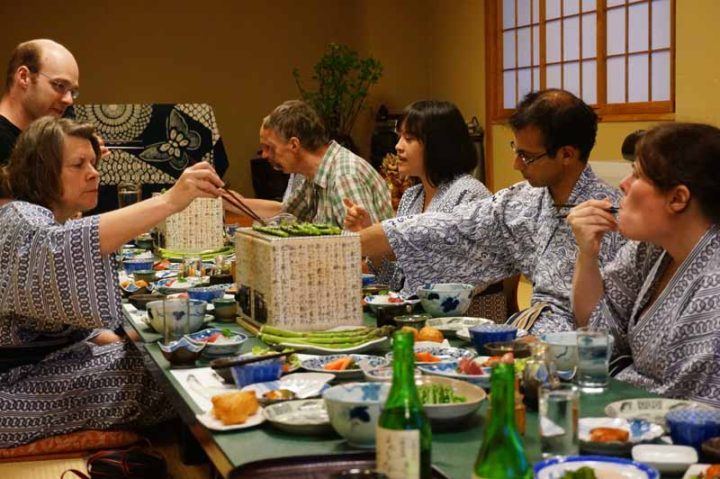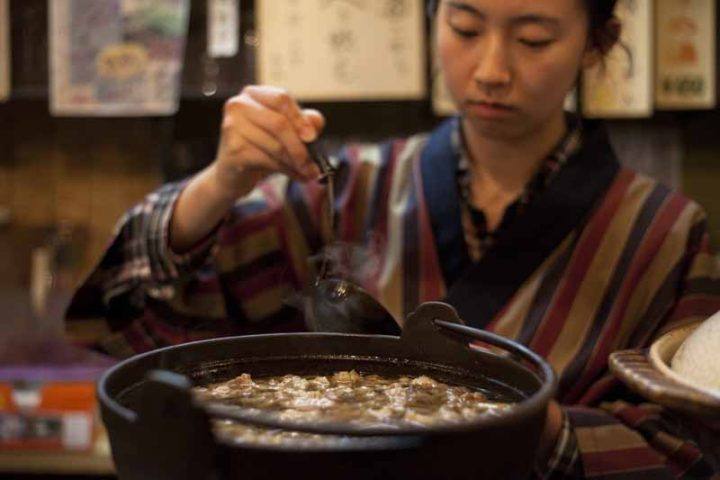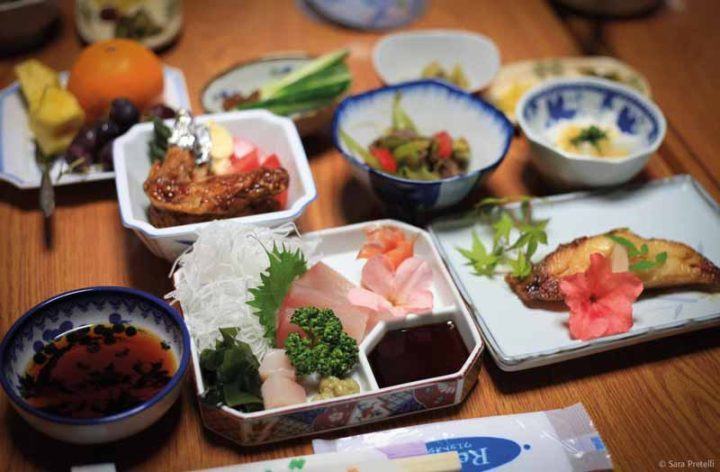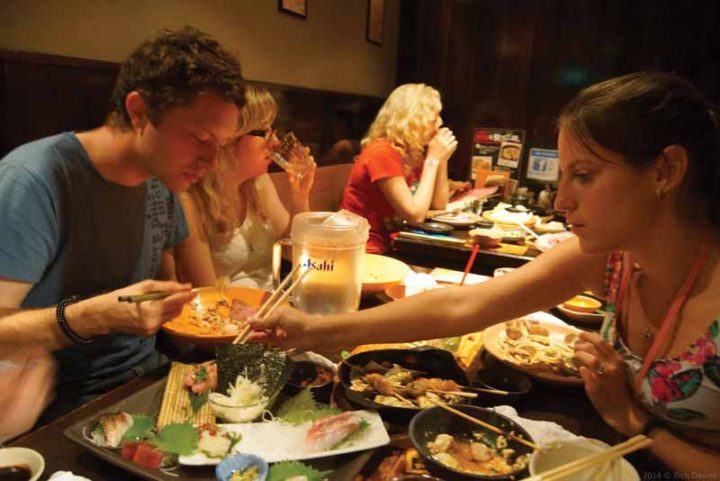Like this post? Help us by sharing it!
When it comes to navigating the minefield that is Japanese etiquette, nobody does it better than us. Today it’s time to delve into the wonderful – and complicated – world of eating & drinking in Japan! It may all be a bit bewildering at first, but you’ll get the hang of it.
Clean your hands before eating
Nearly everywhere you go, from the lowliest fast food restaurant to the swankiest cocktail bar, you’ll be handed an oshibori – or wet hand towel – with which to wash your hands before eating. As a nice touch, these are usually chilled in the summer and heated in the winter!
Be prepared to sit on the floor
At traditional-style Japanese restaurants, be warned that it’s de rigueur to sit on the floor – so if this isn’t comfortable, be sure to check if they have Western-style tables! At such restaurants, you’ll need to remove your shoes before entering and the waiters will squirrel them away until your return.

Don’t blow your nose at the table
Whereas in the West it’s rude to sniff, in Japan it’s rude to blow your nose in public – especially at the dinner table – so head to the bathroom if you need to clear the airways.
Slurp!
Slurping your noodles at home might earn you a few dirty looks from your fellow diners, but in Japan it’s considered a sign that you’re appreciating your meal – so slurp away!
Pick up your bowl
It’s perfectly good manners in Japan to pick up the bowl you’re eating from in one hand while you eat, and totally acceptable to drink soup straight from the bowl.

Brush up on chopstick etiquette
There is so much etiquette surrounding chopstick use that many Japanese people don’t even know what’s right. For example, you’ll find some sources claiming that the correct way to take food from a communal plate is with the opposite end of your own chopsticks, while others claim that using your own chopsticks (and excusing yourself) or using a fresh pair of chopsticks is proper manners.
As Hugh Jackman found out to his detriment, standing your chopsticks upright in your bowl is very bad manners as it’s reminiscent of the incense at funerals. Similarly, passing food between chopsticks is also taboo as it recalls funeral customs.
https://www.youtube.com/watch?v=3KnI6w-naGE
Other little-known chopstick tips are: don’t rest your chopsticks across the top of your bowl (use the chopstick rest or paper packet); don’t raise your food about the level of your mouth; don’t hover over food with your chopsticks, nor touch food with your chopsticks and not take it; don’t lick your chopsticks; don’t stab your food with your chopsticks; don’t pick up your chopsticks before you pick up your bowl (but do put down your chopsticks whenever you change bowls); don’t move your plate or bowl around using your chopsticks; don’t look for contents in a soup with chopsticks… and so on and so forth.
Some of these “rules” are common knowledge, some of them are quite obscure – but most Japanese people will be delighted that you can even pick up a pair of chopsticks at all, so don’t worry too much about getting it wrong. Your Japanese companions will not be offended, and will be happy to show you the correct way.
Don’t pour soy sauce over white rice
The Japanese are very proud of their rice, and would never pour soy sauce over rice for fear of offending the cook.
Don’t put wasabi in your soy sauce
Apparently, the proper way is to put a dollop of wasabi on your sushi, then dip it (fish-side down) in your soy sauce. The idea is that any sushi that goes well with wasabi will already contain it, so by adding more you’re essentially second-guessing the sushi chef (in the same way chefs in the West are offended by customers adding salt to their meals).
I was upset to find out about this rule, because I like masses of wasabi on everything – and I especially like dissolving wasabi in my soy sauce. And if that makes me uncouth, so be it – some rules were made to be broken.
Don’t walk and eat
I lived in Japan for eight months before I realised this was a thing. Eight months of walking about, chomping away to my heart’s content and probably offending people everybody who saw me with my barbaric habits. So you’re welcome for the heads-up.
Don’t pour your own drink
When eating and drinking out in Japan, it’s customary to let others pour your drinks and to pour theirs for them. Keep checking throughout the meal to see if anyone’s running low! And don’t forget to wait for the kanpai (cheers) before you drink.
Eat everything (if you can…)
Do you remember the HSBC advert where the English businessman keeps clearing his plate, only to be brought more eels to eat by his Chinese hosts? No? Well never mind. In China clearing your plate may mean that you’re questioning your hosts’ generosity (I’ll have to trust HSBC on that one. You can trust them, right?) but this is not the case in Japan – where clearing your plate is good form. This is lucky for you, because the food’s incredible. If you can’t clear your plate (as is often the case with lavish ryokan meals!) don’t worry – your hosts will understand.
… and in case you don’t know what I’m talking about:
https://www.youtube.com/watch?v=6_WAmt3cMdk
Keep it neat
Traditional Japanese meals often consist of large trays filled with little pots, baskets, plates and bowls for you to try. At the end of your meal, it’s good manners to return everything to the arrangement in which you found it: chopsticks resting on their paper holder, lids on teapots and bowls in saucers. If you can’t remember where it went, it doesn’t matter – just keep it neat.

Don’t be late – and never cancel
This is a very common cultural faux pas committed by Western tourists – who are used to skipping their hotel breakfast or cancelling a restaurant reservation at the drop of a hat. Unlike some of the finer points of etiquette on this list, ignoring this one is pretty much guaranteed to offend.
If you’ve made a restaurant reservation, stick to it – and don’t be late. It’s very rude to cancel, and it’s not unusual for an establishment to demand a percentage (or even the entirety) of your meal cost as compensation, which can come as a nasty shock if you’re not expecting it. It’s simply part of the culture of dining out in Japan.
On a similar note, if you’re staying at a Japanese-style inn (ryokan), never skip breakfast. These aren’t the slap-dash buffet breakfasts you’re used to – they’re freshly prepared, intricate, multi-dish affairs that take quite a bit of planning and preparation to pull off. Skipping them costs someone a lot of time and effort, and you’ll be considered very rude.

Make your special requests in advance
In the UK or the USA, it’s not unusual to ask your waiter for your beefburger with a gluten-free bun, no tomatoes, extra mustard and hold the mayo. This is not the done thing in Japan, and many restaurants will not be able to cater to your requests on an ad hoc basis.
If you have a dietary requirement, you need to advise your ryokan or restaurant at the time of reservation, so they can prepare the ingredients for your meal in advance. Where this isn’t possible (if you’re just popping into a café, for instance) just make sure to tell the waiter about your dietary requirement before you sit down – they’ll soon tell you whether they can cater for you or not!
Read more about dietary requirements in Japan.
Get in touch with us to find out more and begin planning your trip today! For more on Japanese customs & etiquette, see below:
Japanese etiquette 101: How to onsen


